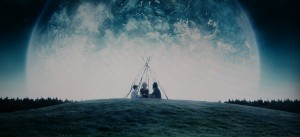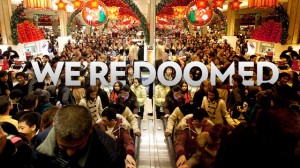Mayan hieroglyphics aren’t science fiction–though one could argue that as a basis of myths and legends, hieroglyphics are proto-proto-science fiction–but some people and some genres of literature, including sci-fi (remember that film 2012? Neither do I.), have embraced them in order to advance a doomsday scenario.
So, could the world end tomorrow?
The easy answer is that sure, it could. Bigfoot could also come over for tea and crumpets, and my cat could suddenly begin speaking in Latin. But, sadly, I doubt those things will happen. And, according to Mayan experts and scientists, it seems likely that the world will keep chugging right along.
The 13th 400-year-long cycle of the Mayan calendar, called a bak’tun, is ending on Dec 21. Perhaps the unlucky association of the number 13 contributed to people thinking that this bak’tun would be the last. The end of the cycle holds primarily religious significance, rather than practical or apocalyptic significance, which is why the Mayans noted the date in the first place. Those glyphs don’t contain any actual prophecies, doomsday or otherwise.
People may have concluded that the date signified the end of the world because common lore is that the Mayan calendar stops in 2012. However, this is another misconception. The Mayan calendar actually extends another 2,400 years beyond December 21st. So we can start worrying again in the year 4,400–if the world hasn’t already ended by then.
When prophecies have no basis in reality, people often turn to science for some kind of data that can be (mis)construed as evidence.
Some people believe that the ancient Sumerians discovered a planet, Nibiru, which was predicted to collide with earth in 2003. When that didn’t happen, apocalyptics looked to the next nearest important celestial date and then merged that rumor with the Mayan one. Always game to debunk cosmological myths, NASA says that if this were even a remote possibility, they would have been tracking such a planet for years and that by now, we’d all be able to see it, like in last year’s cataclysmic movie Melancholia. NASA assures us that this scenario belongs in the movies only.
Some people claim that the world will end on the 21st because the Earth will be in extremely rare alignment with other planets, and/or the sun, and/or a black hole. However, according to NASA, and according to maps of the current positions of the planets, no such alignment will occur. However, on the 21st, which happens to be the Winter Solstice, the Sun will cross the Milky Way’s equator at 11:11 am GMT (that’s 6:11 am for us East Coasters). The unusual aspect of this alignment is that it will occur along the plane of the entire Milky Way, an event known as the procession of the equinoxes. During this procession, the position of the stars changes in terms of their latitude, or equatorial coordinates, and its (ecliptic) longitude, and the Earth’s rotational axis will trace a cone shape. The procession of the equinoxes, otherwise known as an axial procession, occurs once every 26,000 years, thus fomenting the doomsayers’ greatest fear (or wildest fantasy) that the Earth would somehow not be able to survive this alignment. Regardless, the Mayans’ ability to foresee such a rare alignment further substantiates of their credibility and reputation as an ancient people closely in tune with the heavens.
Others think that on the 21st, perhaps as a result of this alignment, the planet’s magnetic poles will reverse. Now, this part isn’t quite as far-fetched—Earth’s poles do reverse. This doesn’t occur like clockwork, and the causes are still disputed, but on average this happens about every 400,000 years. Regardless, scientists say that no such reversals are expected in the next couple thousand years, and NASA says that even if such a reversal occurred, scientists don’t think humans would be harmed.
The December 21, 2012 end of days is fiction, plain and simple. So why does such an unseemly rumor persist?
The Mayan doomsday prediction reflects our obsession with the end of days, which isn’t so different from an individual’s obsession with his or her own mortality. The scope of our knowledge has expanded exponentially in the past few decades, and it makes sense that the scope of our imagined tragedies would expand too.
We like talking and thinking about the end of the world, for whatever reason–perhaps simply because we like drama, and we like narratives that embrace drama. Prognostication, which people generally tend to find fascinating regardless of origin, also adds to that drama by introducing an element of right or wrong, as well as an occasion for an “I told you so.” Remember the most recent Rapture? The Rapture inspired all kinds of silliness, including this entrepreneurial business, which I can’t help but kind of love (though don’t all dogs to go heaven?)
Ultimately, many narratives, science fiction and otherwise, will continue to embrace the narrative and dramatic opportunities presented by the end of the world scenario.
And if you’re a doomsayer, you’ve got plenty of chances after Dec 21.
Back in the early 1700s, Isaac Newton said that based on his calculations, the world wouldn’t and couldn’t end before 2060. Of course, he didn’t say it would end in 2060, but I’ll bet all my apples that a contingent of Newtonians start talking about end times in about forty years.
Although by then, we’ll all be immortal anyway.
If you’ve been an “apocalypse half-full” kind of person, you may have shirked your holiday duties in favor of time better spent. But it’s probably time to go buy those Christmas presents after all. Perhaps there will be some “Earth hasn’t gone black” Friday sales.



